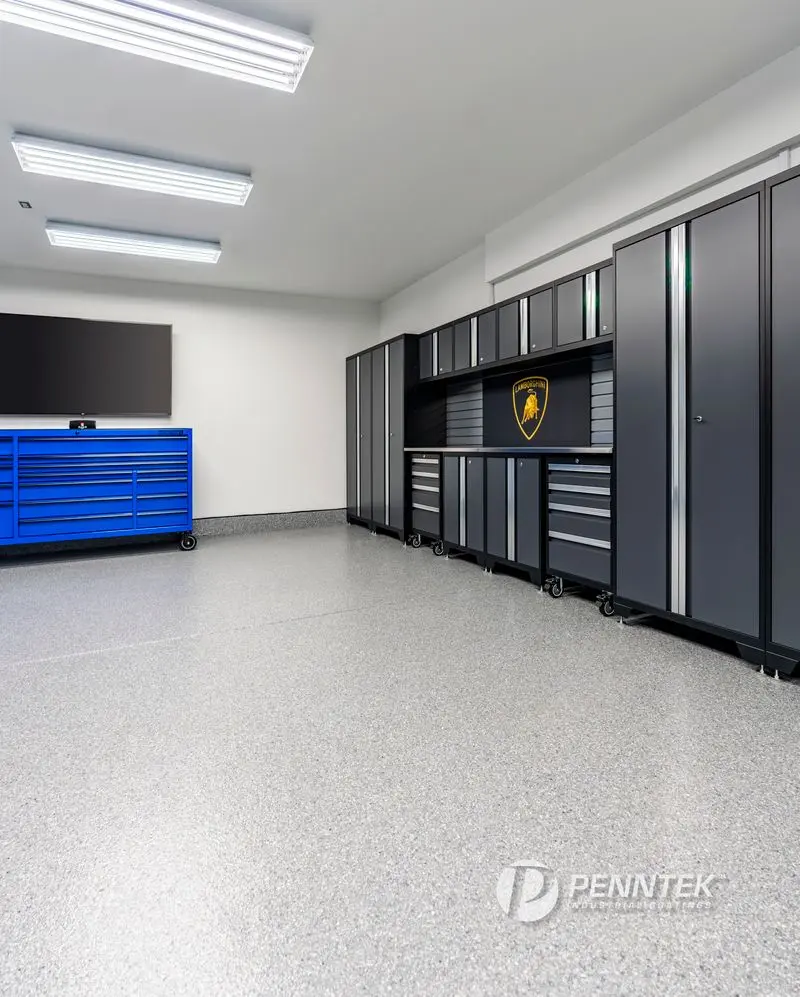Introduction to Garage Floor Resurfacing
Garage floor resurfacing isn’t simply about making your commercial space look good; it’s essential for safety and longevity. It all comes down to getting rid of the old, worn-out surface and putting on a new one that can handle heavy traffic, resist stains, and keep looking sharp. What’s the big deal, you ask? Well, first, if your garage floor looks beat up or unsafe, it reflects poorly on your business. Second, a freshly done floor is easier to clean, meaning less time and money spent on maintenance. And let’s not forget, a resurfaced floor can take a beating from all sorts of heavy stuff without giving in. So, when you opt for garage floor resurfacing, you aren’t just spiffing up the place; you’re making a smart business move. Think of it as a revamp that not only boosts the space’s functionality but also its appeal.
The Importance of a Durable Garage Floor for Commercial Spaces
In commercial spaces, the garage floor isn’t just about looks; it’s about durability and safety. Think about it. A garage that sees daily traffic from heavy vehicles needs a floor that can take a beating without chipping away or cracking. It’s not just the heavy loads, but also spills from oils and chemicals that are common in such areas. A durable garage floor means less time worrying about repairs and more time focusing on business. This isn’t about splurging on expensive options. It’s about investing in a floor that will last, reduce maintenance costs, and boost the overall safety of the space. Here’s the deal: a well-maintained floor is also a reflection of your business’s commitment to quality and safety. So, investing in a durable garage floor isn’t just practical; it’s strategic.
Different Methods of Garage Floor Resurfacing Explained
When talking about giving your commercial garage a new lease on life, there’s no better way than floor resurfacing. Let’s break down the options, so you know what’s what. First up, we have epoxy coating. This is like a superhero cape for your floor. It’s resilient, comes in various colors, and can take a beating from heavy machinery. Plus, it’s got that glossy look that screams professional. Then, there’s polished concrete. It’s exactly what it sounds like. Your existing concrete floor is ground and polished until it shines. It’s durable, easy to clean, and gives off a sleek, modern vibe. Next on the list is stamped concrete. This method is all about looks. It imitates the appearance of stone, brick, or even wood. It’s a great way to add some character to your space without breaking the bank. And lastly, we’ve got interlocking tiles. If you’re looking for something quick and customizable, this is it. These tiles can handle heavy loads, are easy to replace, and come in various designs. Each of these methods has its own set of advantages. The best choice depends on your budget, the look you’re going for, and how you use your garage space.
How Resurfacing Enhances the Look and Feel of Your Garage
Resurfacing your commercial garage floor isn’t just about fixing cracks or hiding stains; it’s a game-changer for the entire space. With the right materials and a skilled team, that dull, lifeless floor transforms into a sleek, modern surface that screams professionalism. Think about it. First impressions matter. Clients or customers rolling into a garage with a high-grade, polished floor will immediately think, “These folks mean business.” It’s not just aesthetics. A resurfaced floor is easier to clean and maintain, substantially cutting down the hassle of dealing with dust and spills. Plus, safety improves. With the option to add non-slip textures, the chances of slips and accidents decrease, which is a big win for everyone. So, resurfacing does more than just make your garage look pretty; it turns it into a more functional, impressive part of your commercial property.
The Role of Proper Preparation for Resurfacing
Before you dive into resurfacing your garage floor, the key step you can’t skip is proper preparation. Think of it as setting the stage for a flawless finish. Getting this part right means your resurfaced floor won’t just look better, but it’ll also last much longer. First off, clean the floor. It sounds simple, but it’s about getting rid of oils, dirt, and any chemicals. This isn’t just a quick sweep. You might need a degreaser and a pressure washer for this job. Next comes fixing cracks and chips. If you ignore these, they’ll just get worse under the new surface. Use concrete filler to make the floor as smooth as possible. After fixing the flaws, you need to roughen up the floor. This might sound backward, but a rough surface helps the new covering stick better. You can do this by acid etching or grinding. The choice depends on what your resurfacing material needs. This preparation might feel like extra work, but it’s the backbone of the whole process. Do it right, and your garage floor will not only look top-notch but also stand up to the heavy demands of a commercial space.
Cost-Benefit Analysis of Garage Floor Resurfacing
Resurfacing your garage floor isn’t just about making it look good; it’s an investment. Yes, the initial cost can seem steep, but let’s break it down. Imagine shelling out around (3 to )12 per square foot depending on the resurfacing type you choose. Now, think about what you’re getting in return. Firstly, a well-done resurfacing job can hugely improve the aesthetic of your commercial space. This isn’t just about vanity. A good-looking garage can make a strong first impression on clients or customers. They see a clean, professional space, and that reflects well on your business.
Secondly, we’re talking about durability. Resurfacing gives your garage floor a protective layer that’s resistant to stains, cracks, and chips. It can handle heavy traffic without showing much wear and tear. This means less money spent on repairs and maintenance in the long run. So, while the upfront cost is there, the expense over time decreases. Plus, a durable floor reduces the risk of accidents. Safer spaces lower the chances of liabilities for your business.
Lastly, consider the value addition. A well-maintained garage floor can boost the property’s overall value. If the time comes to sell the space or lease it out, a high-quality floor could be a deciding factor for potential buyers or tenants.
In essence, the cost of resurfacing your garage floor should be viewed not just as an expense, but as a strategic investment into your commercial property’s future.
Step-by-Step Guide to the Resurfacing Process
First things first, clear everything off your garage floor. Everything needs to go. Next, fix any cracks or damage. This step is crucial; don’t skip it. Your floor won’t look good if it’s all cracked up, even after resurfacing. Okay, now clean the floor. And I mean really clean it. Dust, dirt, oil spots—everything has to go. Here’s where things get a bit technical but stay with me. You’ll need to roughen up the surface. This can be done through acid etching or grinding. This helps the new surface stick. Finally, it’s time to apply the new surface. Choose your material—epoxy, polyurea, or something else—and get to work. Apply it evenly, following the product’s instructions. There you go. Give it time to dry, and your garage floor will look brand new. This process not only improves the appearance but it also increases durability.
Maintenance Tips After Resurfacing Your Garage Floor
After you’ve given your garage floor a fresh start with resurfacing, keeping it in top shape is crucial. Here’s how to do it without breaking a sweat. First off, give your floor a good sweep at least once a week. Dirt and debris can be more than just an eyesore; they can actually scratch the surface over time. And when spills happen, and they will, wipe them up fast. Whether it’s oil, grease, or just a spilled drink, leaving it can lead to stains or damage. Also, consider using a mild cleaner for deeper cleaning. Harsh chemicals can be too aggressive for your new floor. Another key point is to watch the load. Heavy equipment or extreme weights can harm the floor, so know what it can handle. Lastly, every so often, check for any chips or cracks. Catching them early means easier fixes. Stick with these simple steps, and your resurfaced garage floor will keep looking great and performing well for years to come.
Case Studies: Successful Garage Floor Resurfacing Projects
In the world of commercial spaces, the state of your garage floor says a lot. It’s not just about looking good, but also about being functional and safe. Let’s dive into a few case studies where garage floor resurfacing turned tired, worn-out spaces into vibrant, efficient work areas.
Case Study 1: The Auto Repair Shop Makeover
An old auto repair shop struggled with a cracked and oil-stained floor. The owners decided it was time for a change. They opted for an epoxy resurfacing solution, known for its durability and resistance to chemicals. The result? A bright, shiny floor that not only lifted the aesthetics but also improved safety and made cleaning up spills a breeze. What’s more, the reflective surface helped to enhance lighting in the workspace, making every task a little easier.
Case Study 2: The Warehouse Conversion
A large warehouse, previously used for storage, needed a new lease on life as a commercial retail space. The concrete floor was uneven and dusty. The solution was a self-leveling polymer overlay, applied over the existing concrete. This not only created a smooth, attractive foundation but also incorporated colors and patterns that aligned with the brand’s image. The transformation was astounding, turning a once drab space into a trendy and inviting retail environment.
Case Study 3: The Parking Garage Revamp
Parking garages may not need to be pretty, but they do need to be tough. In this case study, a city parking garage was dealing with severe wear and tear from heavy daily use. The resurfacing choice here was a heavy-duty, slip-resistant coating, specially formulated to handle high traffic and extreme conditions. Not only did this extend the garage’s lifespan, but it also significantly improved safety for users, reducing the risk of slips and falls.
These examples show that no matter the type of commercial space, the right resurfacing project can dramatically improve aesthetics, functionality, and safety. It’s not just about making a
Conclusion: Why Garage Floor Resurfacing is a Worthwhile Investment
In the end, opting for garage floor resurfacing in your commercial space is a solid move. It’s not just about making the place look good—it’s way more than that. First, it shoots up your property’s value. That’s a big win whether you’re planning to sell soon or down the line. Also, it’s about safety. A smooth, non-slip surface means fewer trips and falls, protecting your people and your business. Maintenance gets easier, too. You won’t be spending weekends scrubbing stains or fixing cracks. And let’s not forget, it can really make your space stand out. Imagine clients walking in and the first thing they notice is that sleek, professional-looking floor. It speaks volumes about how you run your business. So, is it worth it? Absolutely. The upfront cost might make you think twice, but the long-term benefits of garage floor resurfacing are too good to pass up.

